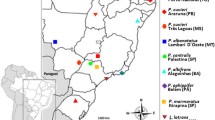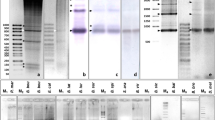Abstract
Highly repetitive DNA sequences of the centromeric heterochromatin provide valuable molecular cytogenetic markers for the investigation of genomic compartmentalization in the macrochromosomes and microchromosomes of sauropsids. Here, the relationship between centromeric heterochromatin and karyotype evolution was examined using cloned repetitive DNA sequences from two snake species, the habu snake (Protobothrops flavoviridis, Crotalinae, Viperidae) and Burmese python (Python bivittatus, Pythonidae). Three satellite DNA (stDNA) families were isolated from the heterochromatin of these snakes: 168-bp PFL-MspI from P. flavoviridis and 196-bp PBI-DdeI and 174-bp PBI-MspI from P. bivittatus. The PFL-MspI and PBI-DdeI sequences were localized to the centromeric regions of most chromosomes in the respective species, suggesting that the two sequences were the major components of the centromeric heterochromatin in these organisms. The PBI-MspI sequence was localized to the pericentromeric region of four chromosome pairs. The PFL-MspI and the PBI-DdeI sequences were conserved only in the genome of closely related species, Gloydius blomhoffii (Crotalinae) and Python molurus, respectively, although their locations on the chromosomes were slightly different. In contrast, the PBI-MspI sequence was also in the genomes of P. molurus and Boa constrictor (Boidae), and additionally localized to the centromeric regions of eight chromosome pairs in B. constrictor, suggesting that this sequence originated in the genome of a common ancestor of Pythonidae and Boidae, approximately 86 million years ago. The three stDNA sequences showed no genomic compartmentalization between the macrochromosomes and microchromosomes, suggesting that homogenization of the centromeric and/or pericentromeric stDNA sequences occurred in the macrochromosomes and microchromosomes of these snakes.






Similar content being viewed by others
References
Beçak W, Beçak ML (1969) Cytotaxonomy and chromosomal evolution in Serpentes. Cytogenetics 8:247–262
Beçak W, Beçak ML, Nazareth HRS, Ohno S (1964) Close karyological kinship between the reptilian suborder Serpentes and the class Aves. Chromosoma 15:606–617
Belterman RHR, de Boer LEM (1984) A karyological study of 55 species of birds, including karyotypes of 39 species new to cytology. Genetica 65:39–82
Capriglione T, Olmo E, Odierna G, Smith DI, Miller OJ (1989) Genome composition and tandemly repetitive sequence at some centromeres in the lizard Podarcis s. sicula Raf. Genetica 79:85–91
Capriglione T, Cardone A, Odierna G, Olmo E (1991) Evolution of a centromeric satellite DNA and phylogeny of lacertid lizards. Comp Biochem Physiol B 100:641–645
Capriglione T, Cardone A, Odierna G, Olmo E (1994) Further data on the occurrence and evolution of satellite DNA families in the lacertid genome. Chromosome Res 2:327–330
Capriglione T, De Santo MG, Odierna G, Olmo E (1998) An alphoid-like satellite DNA sequence is present in the genome of a lacertid lizard. J Mol Evol 46:240–244
Castoe TA, Gu W, de Koning AP, Daza JM, Jiang ZJ, Parkinson CL et al (2009) Dynamic nucleotide mutation gradients and control region usage in squamate reptile mitochondrial genomes. Cytogenet Genome Res 127:112–127
Castoe TA, Hall KT, Guibotsy Mboulas ML, Gu W, de Koning AP, Fox SE et al (2011) Discovery of highly divergent repeat landscapes in snake genomes using high-throughput sequencing. Genome Biol Evol 3:641–653
Chaiprasertsri N, Uno Y, Peyachoknagul S, Prakhongcheep O, Baicharoen S, Charernsuk S et al (2013) Highly species-specific centromeric repetitive DNA sequences in lizards: molecular cytogenetic characterization of a novel family of satellite DNA sequences isolated from the water monitor lizard (Varanus salvator macromaculatus, Platynota). J Hered 104:798–806
Charlesworth B, Sniegowski P, Stephan W (1994) The evolutionary dynamics of repetitive DNA in eukaryotes. Nature 37:215–220
Ciobanu D, Grechko VV, Darevsky IS, Kramerov DA (2004) New satellite DNA in Lacerta s. str. lizards (Sauria: Lacertidae): evolutionary pathways and phylogenetic impact. J Exp Zool B Mol Dev Evol 302:505–516
Csink AK, Henikoff S (1998) Something from nothing: the evolution and utility of satellite repeats. Trends Genet 14:200–204
de Boer LEM, Sinoo RP (1984) A karyological study of Accipitridae (Aves: Falconiformes), with karyotypic descriptions of 16 species new to cytology. Genetica 65:89–107
Giovannotti M, Nisi Cerioni P, Caputo V, Olmo E (2009) Characterisation of a GC-rich telomeric satellite DNA in Eumeces schneideri Daudin (Reptilia, Scincidae). Cytogenet Genome Res 125:272–278
Giovannotti N, Nisi Cerioni P, Splendiani A, Ruggeri P, Olmo E, Caputo Barucchi V (2013) Slow evolving satellite DNAs: the case of a centromeric satellite in Chalcides ocellatus (Forskâl, 1775) (Reptilia, Scincidae). Amphibia-Reptilia 34:401–411
Giovannotti M, Rojo V, Nisi Cerioni P, González-Tizón A, Martínez-Lage A, Splendiani A et al (2014) Isolation and characterization of two satellite DNAs in some Iberian rock lizards (Squamata, Lacertidae). J Exp Zool B Mol Dev Evol 322:13–26
Grechko VV, Ciobanu DG, Darevsky IS, Kramerov DA (2005) (2005) Satellite DNA of lizards of the genus Lacerta s. str. (the group L. agilis), the family Lacertidae. Dokl Biochem Biophys 400:44–47
Grechko VV, Fedorova LV, Ryabinin DM, Ryabinina NL, Ciobanu DG, Kosushkin SA, Darevsky IS (2006) The use of nuclear DNA molecular markers for studying speciation and systematics as exemplified by the “Lacerta agilis complex” (Sauria: Lacertidae). Mol Biol 40:51–62
Henikoff S, Ahmad K, Malik HS (2001) The centromere paradox: stable inheritance with rapidly evolving DNA. Science 293:1098–1102
Ishishita S, Tsuruta Y, Uno Y, Nakamura A, Nishida C, Griffin DK et al (2014) Chromosome size-correlated and chromosome size-uncorrelated homogenization of centromeric repetitive sequences in New World quails. Chromosome Res 22:15–34
Jelinek WR, Schmid CW (1982) Repetitive sequences in eukaryotic DNA and their expression. Ann Rev Biochem 51:813–844
Kawagoshi T, Nishida C, Matsuda Y (2012) The origin and differentiation process of X and Y chromosomes of the black marsh turtle (Siebenrockiella crassicollis, Geoemydidae, Testudines). Chromosome Res 20:95–110
Kawai A, Nishida-Umehara C, Ishijima J, Tsuda Y, Ota H, Matsuda Y (2007) Different origins of bird and reptile sex chromosomes inferred from comparative mapping of chicken Z-linked genes. Cytogenet Genome Res 117:92–102
Kumazawa Y (2007) Mitochondrial genomes from major lizard families suggest their phylogenetic relationships and ancient radiations. Gene 388:19–26
Masumoto H, Masukata H, Muro Y, Nozaki N, Okazaki T (1989) A human centromere antigen (CENP-B) interacts with a short specific sequence in alphoid DNA, a human centromeric satellite. J Cell Biol 109:1963–1973
Matsubara K, Tarui H, Toriba M, Yamada K, Nishida-Umehara C, Agata K et al (2006) Evidence for different origin of sex chromosomes in snakes, birds, and mammals and step-wise differentiation of snake sex chromosomes. Proc Natl Acad Sci U S A 103:18190–18195
Matsubara K, Yamada K, Umemoto S, Tsuchiya K, Ikeda N, Nishida C et al (2008) Molecular cloning and characterization of the repetitive DNA sequences that comprise the constitutive heterochromatin of the A and B chromosomes of the Korean field mouse (Apodemus peninsulae, Muridae, Rodentia). Chromosome Res 16:1013–1026
Matsuda Y, Chapman VM (1995) Application of fluorescence in situ hybridization in genome analysis of the mouse. Electrophoresis 16:261–272
Matsuda Y, Harada Y-N, Natsuume-Sakai S, Lee K, Shiomi T, Chapman VM (1992) Location of the mouse complement factor H gene (cfh) by FISH analysis and replication R-banding. Cytogenet Cell Genet 61:282–285
Matzke MA, Varga F, Berger H, Schernthaner J, Schweizer D, Mayr B et al (1990) A 41-42 bp tandemly repeated sequence isolated from nuclear envelopes of chicken erythrocytes is located predominantly on microchromosomes. Chromosoma 99:131–137
Matzke AJM, Varga F, Gruendler P, Unfried I, Berger H, Mayr B et al (1992) Characterization of a new repetitive sequence that is enriched on microchromosomes of turkey. Chromosoma 102:9–14
Ohno S (1972) So much “junk” DNA in our genome. Brookhaven Symp Biol 23:366–370
Olmo E, Signorino G (2005) Chromorep: a reptile chromosomes database. Retrieved from: http://chromorep.univpm.it
Orgel LE, Crick FHC (1980) Selfish DNA: the ultimate parasite. Nature 284:604–607
Pyron RA, Burbrink FT, Wiens JJ (2013) A phylogeny and revised classification of Squamata, including 4161 species of lizards and snakes. BMC Evol Biol 13:93
Saifitdinova AF, Derjusheva SE, Malykh AG, Zhurov VG, Andreeva TF, Gaginskaya ER (2001) Centromeric tandem repeat from the chaffinch genome: isolation and molecular characterization. Genome 44:96–103
Sambrook J, Fritsch FE, Manlatls T (1989) Molecular Cloning: A Laboratory Manual, 2nd edn. Cold Spring Harbor Laboratory Press, New York
Schmidt T, Heslop-Harrison JS (1998) Genomes, genes and junk: the large-scale organization of plant chromosomes. Trend Plant Sci 3:195–199
Singer MF (1982) Highly repeated sequences in mammalian genomes. Int Rev Cytol 76:67–112
Singh L (1972) Evolution of karyotypes in snakes. Chromosoma 38:185–236
Singh L, Purdom IF, Jones KW (1976) The chromosomal localization of satellite DNA in Ptyas mucosus (Ophidia, Colubridae). Chromosoma 57:177–184
Srikulnath K, Matsubara K, Uno Y, Thongpan A, Suputtitada S, Apisitwanich S et al (2009) Karyological characterization of the butterfly lizard (Leiolepis reevesii rubritaeniata, Agamidae, Squamata) by molecular cytogenetic approach. Cytogenet Genome Res 125:213–223
Srikulnath K, Matsubara K, Uno Y, Nishida C, Olsson M, Matsuda Y (2014) Identification of the linkage group of the Z sex chromosomes of the sand lizard (Lacerta agilis, Lacertidae) and elucidation of karyotype evolution in lacertid lizards. Chromosoma 123:563–575
Sumner AT (1972) A simple technique for demonstrating centromeric heterochromatin. Exp Cell Res 75:304–306
Takagi N, Sasaki M (1974) A phylogenetic study of bird karyotypes. Chromosoma 46:91–120
Tanaka K, Suzuki T, Nojiri T, Yamagata T, Namikawa T, Matsuda Y (2000) Characterization and chromosomal distribution of a novel satellite DNA sequence of Japanese quail (Coturnixcoturnix japonica). J Hered 91:412–415
Uetz P, Hošek J (2015) The Reptile Database. Retrieved from: http://www.reptile-database.org/
Uno Y, Nishida C, Tarui H, Ishishita S, Takagi C, Nishimura O et al (2012) Inference of the protokaryotypes of amniotes and tetrapods and the evolutionary processes of microchromosomes from comparative gene mapping. PLoS ONE 7, e53027
Vidal N, Rage J-C, Couloux A, Hedges SB (2009) Snakes (Serpentes). In: Hedges SB, Kumar S (eds) The timetree of life. Oxford University Press, New York, pp 390–397
Yamada K, Nishida-Umehara C, Matsuda Y (2002a) Characterization and chromosomal distribution of novel satellite DNA sequences of the lesser rhea (Pterocnemia pennata) and the greater rhea (Rhea americana). Chromsome Res 10:513–523
Yamada K, Shibusawa M, Tsudzuki M, Matsuda Y (2002b) Molecular cloning and characterization of novel centromeric repetitive DNA sequences in the blue-breasted quail (Coturnix chinensis, Galliformes). Cytogenet Genome Res 98:255–261
Yamada K, Nishida-Umehara C, Matsuda Y (2004) A new family of satellite DNA sequences as a major component of centromeric heterochromatin in owls (Strigiformes). Chromosoma 112:277–287
Yamada K, Nishida-Umehara C, Matsuda Y (2005) Molecular and cytogenetic characterization of site-specific repetitive DNA sequences in the Chinese soft-shelled turtle (Pelodiscus sinensis, Trionychidae). Chromosome Res 13:33–46
Acknowledgments
We are grateful to Michihisa Toriba, Japan Snake Institute, Gunma, and Yoshinori Kumazawa, Nagoya City University, for kindly providing snake samples.
Funding
This research was partially supported by Grants-in-Aid for Scientific Research on Innovative Areas (no. 23113004) and a Grant-in-Aid for Scientific Research (B) (no. 22370081) from the Ministry of Education, Culture, Sports, Science and Technology, Japan.
Conflict of interest
The authors declare that they have no conflict of interest.
Ethical approval
Animal care and all experimental procedures were approved by the Animal Experiment Committee (Approval no. CAST05-003), Graduate School of Science, Hokkaido University, and the experiments were conducted according to the Regulations on Animal Experiments in Hokkaido University.
Author information
Authors and Affiliations
Corresponding author
Electronic supplementary material
Below is the link to the electronic supplementary material.
Supplementary Figure 1
Nucleotide sequences of repeat sequence families. Alignments of 22 PFL-MspI fragments (A), 32 PBI-DdeI fragments (B) and 3 PBI-MspI fragments (C). Dots indicate the same nucleotides as those of the consensus sequence of each sequence family, and the hyphens indicate gaps. Internal restriction sites of eight endonucleases are indicated as follows: (PDF 73 kb)
Rights and permissions
About this article
Cite this article
Matsubara, K., Uno, Y., Srikulnath, K. et al. Molecular cloning and characterization of satellite DNA sequences from constitutive heterochromatin of the habu snake (Protobothrops flavoviridis, Viperidae) and the Burmese python (Python bivittatus, Pythonidae). Chromosoma 124, 529–539 (2015). https://doi.org/10.1007/s00412-015-0529-6
Received:
Revised:
Accepted:
Published:
Issue Date:
DOI: https://doi.org/10.1007/s00412-015-0529-6




